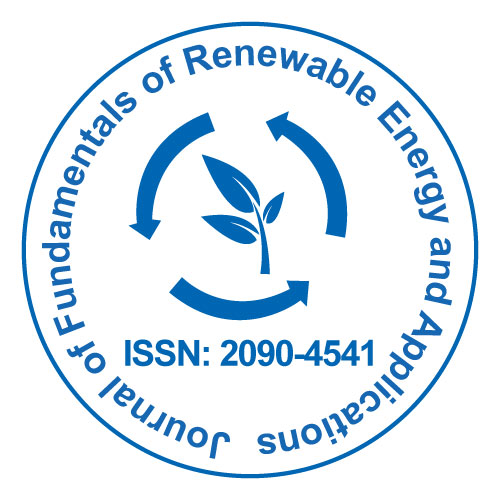
Journal of Fundamentals of Renewable Energy and Applications
Open Access
ISSN: 2090-4541

ISSN: 2090-4541
Andr�?© Pedral Sampaio de Sena1, Lima Jr Ailton de S S2 and Coutinho Osvaldo A1
1Design and Innovation Apollo, Brazil 2Federal University of Bahia, Brazil
Scientific Tracks Abstracts: J Fundam Renewable Energy Appl
The Amazonian is a priceless treasure that needs to be preserved at every cost. Besides being the largest forest of the world with the largest concentration of fresh water and to have the largest biodiversity of the planet, the Amazon forest is a life source, one of the few places in the planet earth where the nature still exercises all your magnificent force. It is difficult to explain in words that every visitor sits down when knowing the Amazonian for the first time: A power never imagined magnetism, forces, emotion, respect, vastness, life and peace. The Amazon forest copper 6, 5 million of KM2 of which 4 million are in Brazilian territory. But, in spite of the Amazon basin to be formed by torrential rivers, the quite permeable soil and the little canyons presence and falls of water, they impede the implantation of hydroelectric plants in the area. Due to vast territorial extension, the Amazonian shelters a riverside population that they don��?t have minimum resources of survival, among them the electric power. But, due to the difficulties of taking the electrification the those communities, and the Brazilian government��?s constants prohibitions to liberate plants that use fuels root, more and more it appears collections and investments in several forms of clean energy generation. This way, in order to promote the sustained development, it is that was born the ARTEMIS project that foresees the rational and intelligent use of waters and waves, with hydraulic potential bass, could have or not a low oxygen level and the presence of solid substances dissolved, with the purpose of electric power production - starting from the combination of a gas turbines system, moved H2, and moved thermal units H2. Basing your pro- posal, in a productive structure at a low cost, with high financial profitability, and occupying a small area, the ARTEMIS project was conceived in modules, resembling each other to proto- units, that has as pattern the constructive easiness, the modular form, easy exchange, the union of innovative technologies and besides everything the capacity to adapt to the needs the generation, could be used from small units of production to gigantic, what will guide your implantation cost. Besides everything, the architecture of the project doesn��?t generate gases of the effect it stews. Like this, the project, while it conserves the environment using up-to-date technology for energy generation, it makes with a low cost, to maintain your process. The volume of energy, produced through this project, it is high, being capable to supply the energy consumption to this associated, this everything starting from a raw material, water of the amazon rivers, tends or not, hydraulic potential bass, creating a process that will lower the production costs energy, besides guaranteeing the quality and environmental protection. Based on a fixed platform, which operates in the middle of rivers or sea, this project was built to take advantage of all conditions generated by the seas, wind and sun to generate power. Thus, the Artemis project brings together three power generation systems: thermal system, mechanical sys- tem and photo-voltaic system. The Arthemis project is similar to a big tarantula. The body of the Tarantula serves as a fixed plat- form to generate energy through photovoltaic panels and wind generators helical. Furthermore, there are electrolyzes, inside which produce hydrogen for power generation through Stirling engine coupled to power generators, that can generate power by solar heating or the combustion of hydrogen but not only the body generates energy, the legs of the tarantula are mobile and they follow the movements of the waves, allowing what eight legs generate energy by the movement of waves. The head of the tarantula is responsible for control of the entire complex.
André Pedral Sampaio de Sena holds PhD in Industrial Engineering - Organizational Intelligence from the Federal University of Santa Catarina (2008), Master in Industrial Engineering - Business Management from the Federal University of Santa Catarina (2002), Computer specialist at Educational Center for Education Graduate Olga Metting (1999), degree in Electrical Engineering from the Federal University of Bahia (1986). He has extensive experience in the areas of Information Technology, Process Engineering, Hydrogen, Bioenergy, Energy Generated, Process Automation, Sustainable Development, Audit and Judicial Skill. He is the Winner of the South Regional – Santander and Winner of 4th Prize Santander Science and Innovation with the project OPTIMUS: Creating a method for assessing the strategic management informed by MCDA-C; Coordinates of the APOLLO research group, developing research projects in the areas of technology, robotics, organizational strategies, clean energy and sustainable development. He is a creator, researcher and coordinator of the Engineering courses of the Faculty of Technology of Valença / Ba – FACTIVA. He is a Founder of FACTIVA’s Technology Center. He is a Professor and researcher at the Federal University of Bahia – UFBA. Coordinator and researcher of the research groups: NDTA – FACTIVA: Advanced Technology Development Center Factiva; And GPAPOLLO – UFBA: Apollo Research Group – UFBA.
Email: apedral@gmail.com